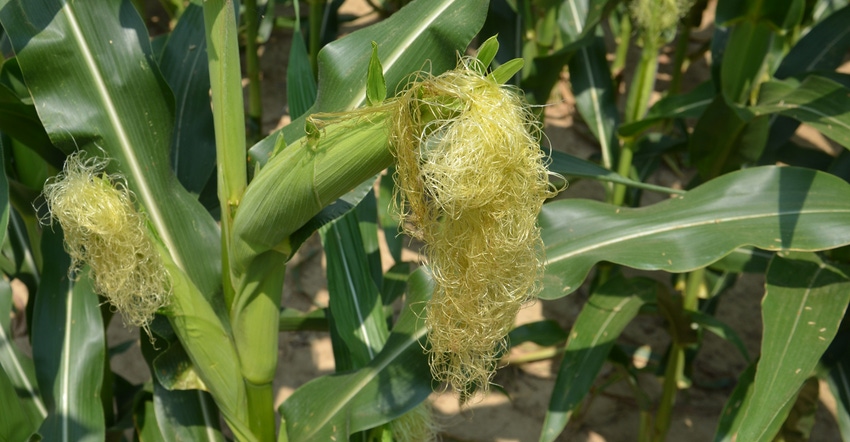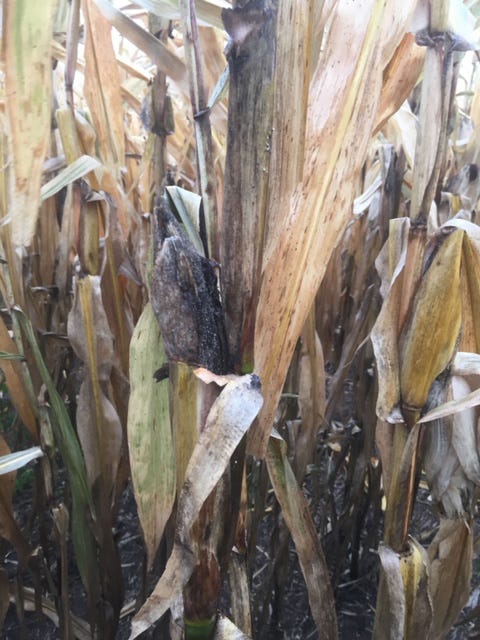
Corn growers may think that once pollination begins, their job is over. Jason Harmon argues that’s a critical time to be in cornfields, scouting and monitoring key parameters. These include evaluating how well pollination fared, checking for late-season diseases and paying attention to potential insect issues.
“Temperature and moisture levels are critical for pollination,” says Harmon, a technical agronomist for Dekalb and Asgrow, based near Delphi and covering northern Indiana. “Most of the pollination process within a hybrid occurs over about five to eight days. By the third day of tasseling, you hope ear shoots and silks are out and ready to receive peak pollen-shed production.”
Excessive heat or drought stress can interfere with timing of pollen shed versus silk emergence, he notes. Normally, unless conditions are extreme, as in 2012, silks emerge in time.
How do you tell if silks have been pollinated? “Length of silks are a clue,” Harmon says. “Silks keep elongating until a pollen grain goes down the tube and fertilizes an ovule. If you see silks 4 to 6 inches long, it’s a good bet those silks haven’t been pollinated yet.”
Once pollination wraps up, there’s a simple but effective way to determine if it was successful, he notes. “Husk back an average ear and hold the ear with silks straight out,” Harmon says. “Do the shake test. If silks fall off, those ovules were pollinated. If silks remain attached, those silks weren’t pollinated yet.”
Disease watch
Evaluating pollination is only one reason to journey into cornfields, Harmon says.
“We began hearing reports of gray leaf spot showing up at the beginning of July in some fields,” he says. “You want to scout carefully and be ready to line up fungicide applications, if necessary.”
DeKalb offers a line of Disease Shield hybrids, which tend to have improved genetic resistance against some of the more troublesome diseases. “If you have those hybrids or other hybrids with good disease packages, scout other fields where you know hybrids are more susceptible first,” Harmon says. “Then take a look at fields with more resistant hybrids.”
In northern Indiana, tar spot has raised concern the past couple of seasons. “We need to watch for the symptoms, because it can come in quickly,” he says. “In 2019, it didn’t come in until later. But it can be very damaging if it comes in hard.”
Tar spot is characterized by tiny black specks on leaves. Unless treated, it can eventually cause entire leaves to die, shutting down the photosynthetic factory and cutting into yields.
Especially in areas south of Harmon’s territory, southern rust deserves attention, as well. “It usually comes in on a storm front from the Gulf,” he explains. “It has made it into northern counties, but if conditions aren’t as favorable for it, you may not have to treat for it.”
Insect issues
Harmon also recommends keeping an eye out for insect pests. “Japanese beetles have been prevalent enough to cause issues clipping silks some years,” he says. “If you’re in the field while corn is pollinating, you want to make sure silk clipping isn’t limiting pollination.”

APHID AFTERMATH: Agronomist Jason Harmon encountered this ugly situation in cornfields where corn aphids moved in late in 2019.

One unusual problem that appeared in the latest-planted corn in 2019 was corn aphids, Harmon notes. With some replanting and spotting-in, and a range in corn growth stages again this year, these aphids could be a concern.
“They can come into late-planted, still-green corn quickly late in the season,” he says. “It’s an insect worth paying attention to if you have late-planted corn.”
About the Author(s)
You May Also Like




